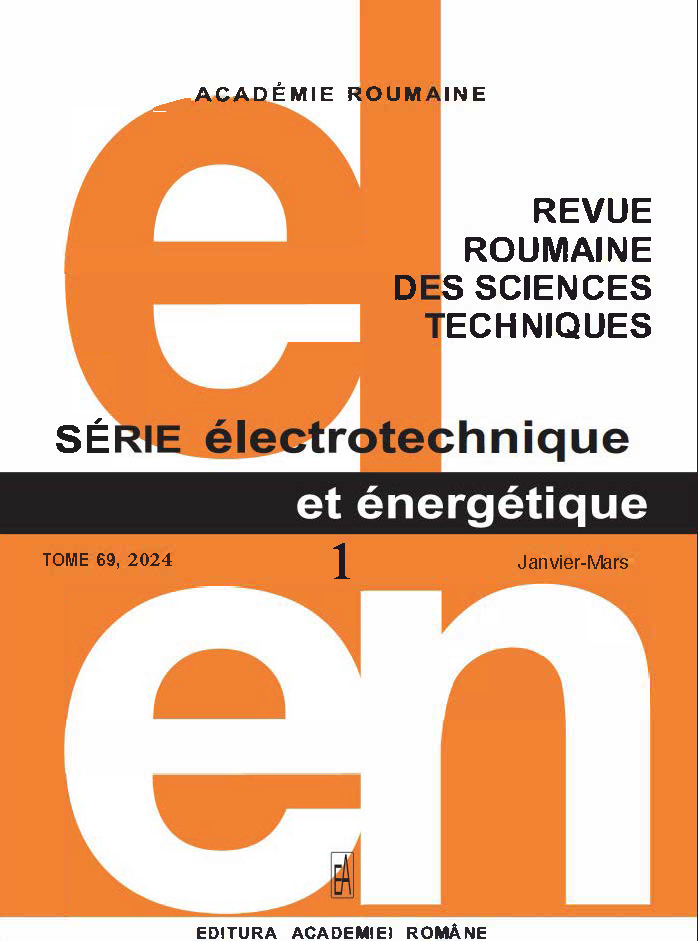LA DÉPENDANCE ENTRE LA VITESSE ANGULAIRE MÉCANIQUE OPTIMALE ET LA VITESSE VARIABLE DU VENT D'UN POINT DE VUE ÉNERGÉTIQUE
DOI :
https://doi.org/10.59277/RRST-EE.2024.1.9Mots-clés :
Vitesse angulaire mécanique optimale, Point de puissance maximale, Système éolien, Contrôle de puissance, Vitesse du ventRésumé
Cet article examine les éléments fondamentaux requis pour faire fonctionner une éolienne (WT) à son point de puissance maximale (MPP). Il se concentre sur la mesure de la vitesse du vent et de la puissance de sortie du générateur électrique (EG) au fil du temps pour établir la relation entre la vitesse angulaire mécanique (MAV) optimale et la vitesse du vent, notée fonction ωOPTIM (V). Cette fonction est cruciale pour contrôler la puissance de sortie du générateur électrique, garantissant ainsi que le WT fonctionne à son point de puissance maximale. L'étude analyse les mesures prises par les turbines de Siliștea en Dobrogea, en Roumanie. L'article se termine en présentant un algorithme pour déterminer la fonction ωOPTIM(V).
Références
(1) J. He, Y. Zhang, S. Yang, C. Li, Z. Hao, Optimal frequency control parameters design of wind farm considering wind turbine grouping, IEEE 6th Conference on Energy Internet and Energy System Integration (EI2), Chengdu, China, pp. 543–548 (2022).
(2) R. Karthik, A. Sri Hari, Y. V. Pavan Kumar, D. John Pradeep, Modelling and control design for variable speed wind turbine energy system, International Conference on Artificial Intelligence and Signal Processing (AISP) (2020).
(3) S. P. Singh, R. Kumar and P. Kumar, Analysis of wind resource on a site using wind turbine mathematical model on MATLAB/Simulink, 2023 5th International Conference on Energy, Power and Environment: Towards Flexible Green Energy Technologies (ICEPE), Shillong, India, pp. 1–6 (2023).
(4) H. Kulkarni, A. Kulkarni, T. Pagire, S. Magdum, mathematical modeling, installation of wind turbine and its analysis in MATLAB, International Conference on Electronics and Renewable Systems (ICEARS), Tuticorin, India, pp. 142–149 (2022).
(5) L. Wang, W. Wang, J. Gong, K. Liao, C. Hu, X. Li, generating capacity improvement method and analysis for the large horizontal axis wind turbine, 3rd International Conference on Advanced Electrical and Energy Systems (AEES), Lanzhou, China, pp. 47–51 (2022).
(6) S. Malekmohammadi, M. Amini, S. Esmaeili, A.A. Najafabadi, S.H. Fathi, impact of the high penetration PMSG-based wind turbine on power system transient stability, 12th Smart Grid Conference (SGC), Kerman, Islamic Republic of Iran, pp. 1–5 (2022).
(7) F. Shiravani, J.A. Cortajarena, P. Alkorta, M.G. Perez, O. Barambones, A predictive control based scheme for maximum power extraction of PMSG based wind turbine systems, IEEE 32nd International Symposium on Industrial Electronics (ISIE), Helsinki, Finland, pp. 1–6 (2023).
(8) Q. Chen et al., Bounded UDE-based MPPT control for wind turbines, 12th International Conference on Information Science and Technology (ICIST), Kaifeng, China, pp. 139–144 (2022).
(9) A.E. Oflaz, M. Yesilbudak, Comparison of outlier detection approaches for wind turbine power curves, 10th International Conference on Smart Grid (icSmartGrid), Istanbul, Turkey, pp. 363–367 (2022).
(10) N.A.N.B. Zainudin et al., Investigation of MPC performance for wind turbine system during wind speed uncertainty, IEEE International Conference on Power and Energy (PECon), Langkawi, Kedah, Malaysia, pp. 346–350 (2022).
(11) A. Routray, S.H. Hur, Predictive Control of Wind turbine using preview wind speed information, IEEE Energy Conversion Congress, and Exposition (ECCE), Detroit, MI, USA, pp. 1–7 (2022).
(12) R. Manikandan, Controlled dynamic analysis of offshore wind turbines under random environmental conditions – experimental investigations, International Conference on Power Electronics and Energy (ICPEE), Bhubaneswar, India, pp. 1–5 (2023).
(13) T.L. Thanh, D.V. Ngoc, E. Muljadi, V.P.T. Hai, M.N.L. Uyen, Wind turbine performance: consideration the execution of power performance verification, 13th International Conference on Power, Energy and Electrical Engineering (CPEEE), Tokyo, Japan, pp. 121–125 (2023).
(14) ***http://www.monsson.eu
(15) ***https://www.vestas.com
Téléchargements
Publiée
Numéro
Rubrique
Licence
(c) Copyright REVUE ROUMAINE DES SCIENCES TECHNIQUES — SÉRIE ÉLECTROTECHNIQUE ET ÉNERGÉTIQUE 2024

Ce travail est disponible sous licence Creative Commons Attribution - Pas d'Utilisation Commerciale - Pas de Modification 4.0 International.


